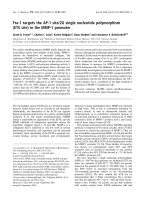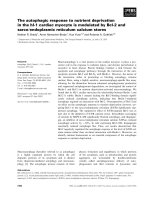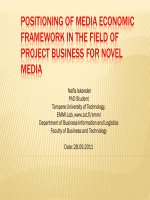Cooking in the Field 1 - Worksheet
Bạn đang xem bản rút gọn của tài liệu. Xem và tải ngay bản đầy đủ của tài liệu tại đây (36.63 KB, 10 trang )
Cooking in the Field 1: Worksheet
Pre-Listening Activities
Whole class: When you are on a field exercise, how do you cook food? Do you use
cookers or a real fire? What kind of cookers do you use? What rules are there for lighting
a fire?
On your own: Complete the following sentences.
A good fire ………………………………..
A bad fire ………………………………….
In pairs: Now show what you have written to your partner and explain what you have
written.
While Listening Activities. (Text One)
Fill in the missing information.
1. Name of Cooker 1 …………………… 2. Type of fuel used ……………………
3. Name of Cooker 2 …………………… 4. Type of fuel used …………………….
5. Rule One for lighting a fire: Get ………………… from ………………………
6. Rule Two for lighting a fire: Don’t …………………………… near …………..
7. Rule Three for lighting a fire: Put ………………. before ………………………..
Complete the following sentences
A) If you just take a pile of ……………… and pile on twigs and ……………… any old way,
you’ll have a great ……………………… with lots of ……………… but one that is useless
for ………….. .
B) What you need is a quick ……………………… that will boil water in a jiffy. One where
the …………. burn down quickly and you are left with nice red hot ………………….. and
no ………….
After Listening Activity
In Pairs: Turn over this worksheet and tell your partner everything you remember about the
text. Now find another partner and do the same.
Attention! A Military English Course for NCOs
Cooking in the Field 2: Worksheet
Pre Listening Activities
Whole class: What problems might you have in using a fire for cooking in the field? How
would you overcome those problems?
In Pairs: Look at the first questions. Guess what the answers may be.
While Listening Activities
Listen and Complete the following sentences
The best place to have a fire is …
Heavy Personnel Carriers and Tanks help because …
Use a trenching tool to …
A breeze blowing through the fire is useful …
Never cook on a fire with a lot of smoke because …
1
2
3
Make maximum use of the fire by …
To cook food efficiently you could wrap it in …..
In Pairs: Check your answers with your partner
Vocabulary
Match the words on the left with their definitions on the right
Embers Something to dig holes with
Mess tin A long narrow hole made by a wheel
A rut with their skins on
A trenching tool a special pan for cooking
A scrape hot glowing bits of a fire
Dodging getting quickly out of the way
(potatoes) in their jackets. A shallow hole in the ground
Listen again and check the answers you gave.
After Listening Activity
Write instructions on how to cook in the field using the information from the two listening
texts.
Attention! A Military English Course for NCOs
Cooking in the Field 1. Answer Key
.
While Listening Activities.
Fill in the missing information.
1. Name of Cooker 1 Butane Gas cooker 2. Type of fuel used gas from a bottle
3. Name of Cooker 2 Tommy Cooker 4. Type of fuel used blocks of solid fuel
5. Rule One for lighting a fire: Get permission from the landowner
6. Rule Two for lighting a fire: Don’t light a fire near anything that can burn
7. Rule Three for lighting a fire: Put out the fire before going to sleep
Complete the following sentences
A) If you just take a pile of dry leaves and pile on twigs and branches any old way,
you’ll have a great big fire with lots of flames but one that is useless for cooking.
B) What you need is a quick hot little fire that will boil water in a jiffy. One where the
flames burn down quickly and you are left with nice red hot glowing embers and no
smoke.
Cooking in the Field 2. Answer Key
.
While Listening Activities
Listen and Complete the following sentences
The best place to have a fire is below ground level
Heavy Personnel Carriers and Tanks help because they make deep ruts
Use a trenching tool to scrape out a hole
A breeze blowing through the fire is useful because it keeps the embers glowing
Never cook on a fire with a lot of smoke because …
1 it will give your position away
2 it makes your pans dirty
3 it’s unpleasant to work with
Make maximum use of the fire by boiling water after cooking
To cook food efficiently you could wrap it in cooking foil
Vocabulary
Match the words on the left with their definitions on the right. (Correct answers are given
below)
Embers hot glowing bits of a fire
Mess tin a special pan for cooking
A rut A long narrow hole made by a wheel
A trenching tool Something to dig holes with
A scrape A shallow hole in the ground
Dodging getting quickly out of the way
(potatoes) in their jackets. with their skins on
Don’t let the enemy see you: Worksheet
Pre-Reading Activities
1. Discuss in pairs and then with the whole class: How do you stop the enemy seeing
you when you are on the battlefield?
2. What do the following words mean? Camouflage. Concealment. Cover.
While Reading Activities:
You are going to read a text. Don’t Let the Enemy See You. As you read the text do the
following activities
1. Write down three ways of camouflaging a soldier.
i. ………………………………………………………………………….
ii. ………………………………………………………………………….
iii. ………………………………………………………………………….
2. Write down five places where you can take cover.
a. ……….…… b. ………………… c………….….d ………..…. e….……..….….
3. Answer the following questions
a) What makes a uniform good at giving camouflage?
……………………………………
b) Where should you put special camouflage paint?
………………………………………
c) What is bad about isolated cover?
………………………………………………………
d) What problem might you have with your rifle?
………………………………………...
e) What problem might you have with your own shadow?
………………………………..
Post Reading activities 1
1. Compare your answers to 1 and 2 with a partner.
2. In pairs ask and answer the questions in task 3.
Attention! A Military English Course for NCOs









